|
|
|
Sort Order |
|
|
|
Items / Page
|
|
|
|
|
|
|
| Srl | Item |
| 1 |
ID:
123357
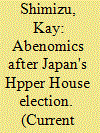

|
|
|
|
|
| Publication |
2013.
|
| Summary/Abstract |
Although July's electoral victory was a necessary condition for pushing Abe's economic program forward, a closer look at the election results and the prime minister's current political positioning reveals a number of challenges ahead."
|
|
|
|
|
|
|
|
|
|
|
|
|
|
|
|
| 2 |
ID:
088468


|
|
|
|
|
| Publication |
2009.
|
| Summary/Abstract |
This paper evaluates the usefulness of a McCallum-type monetary policy rule based on money supply for maintaining price stability in mainland China. We examine whether excess money relative to rule-based values provides information that improves the forecasting of price developments. The results suggest that our monetary variable helps in predicting both consumer and corporate goods price inflation, but the results for consumer prices depend on the forecasting period. Moreover, results using a structural vector autoregression suggest that our measure of excess money supply could be used to identify monetary policy shocks in the Chinese economy.
|
|
|
|
|
|
|
|
|
|
|
|
|
|
|
|
| 3 |
ID:
175033
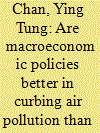

|
|
|
|
|
| Summary/Abstract |
The environmental impacts of macroeconomic policies, and their interaction with climate policies are under-researched in the existing literature. This paper compares the effectiveness of standard macroeconomic tools (fiscal and monetary policies) with carbon taxation in curbing air pollution by using an environmental dynamic stochastic general equilibrium (E-DSGE) model. We show how government expenditure, interest rate, and carbon tax rate should vary over time in order to stabilize carbon emission levels. We find that (i) while all the aforementioned policies could stabilize carbon emissions, their underlying mechanisms are different. Fiscal, monetary, and carbon tax policies, uniquely and respectively, lead to a reduction in abatement effort, income tax revenue, and general price level. (ii) With economic expansions driven by total factor productivity (TFP) shocks, fiscal policy is the only policy that could maintain the emission levels and simultaneously improve household welfare in term of consumption and labor. (iii) Regarding the interaction between carbon and macroeconomic policies, carbon taxation should complement monetary policy, while it should not respond to fiscal policy.
|
|
|
|
|
|
|
|
|
|
|
|
|
|
|
|
| 4 |
ID:
098343


|
|
|
|
|
| Publication |
2010.
|
| Summary/Abstract |
This paper addresses the issue of the impact that armed conflicts have on capital markets. It focuses on the recent Israeli military offensive in the Gaza Strip launched in late 2008 and concluded in early 2009. The paper examines the effects of this armed conflict on the return and volatility of the general index of the Tel Aviv Stock Exchange (TASE), as well as on the government bond index. Furthermore, event study methodology is applied to identify markets' reactions to the Israeli military operations in the Gaza Strip.
|
|
|
|
|
|
|
|
|
|
|
|
|
|
|
|
| 5 |
ID:
133563
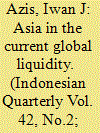

|
|
|
|
|
| Publication |
2014.
|
| Summary/Abstract |
In contrast with the pre~1997/98, today's emerging Asia registers excess savings. Since early 2000s, the liquidity was further boosted by in?ows of capital including those going through the banking sector. After a brief, yet sharp, interruption at the beginning of the global ?nancial crisis, in?ows resumed albeit of different form and inducted by different agents. Nonetheless, the global liquidity sphere has clearly changed. When the quantitative easing tantrum began in May last year, volatility returned. Largely due to a lack of innovative policy response, the episode of vacillating flows produced repercussions not different than in the past because the incentive system remains unchanged. Consequendy, vulnerability still rises with capital ?ows. The 'rational' response of agents is equally predictable, raising the risk of financial instability and exacerbating the already widening income disparity. Nothing is fundamentally new, everyone continues to "dance with the system."
|
|
|
|
|
|
|
|
|
|
|
|
|
|
|
|
| 6 |
ID:
149039
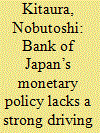

|
|
|
|
|
| Summary/Abstract |
The Bank of Japan has been failing to create the 2% inflation expectations. This article presents the author’s views about why the Bank of Japan’s monetary easing measures have not led to achievement of the inflation target of 2%, as well as on measures required to achieve the 2% inflation (and base wage increases of over 3% which is the flip side of a 2% inflation). The major points of this article are outlined below.
|
|
|
|
|
|
|
|
|
|
|
|
|
|
|
|
| 7 |
ID:
157119
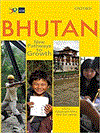

|
|
|
|
|
| Publication |
New Delhi, Oxford University Press, 2017.
|
| Description |
xxxvii, 467p.: tables, figures, boxeshbk
|
| Standard Number |
9780199474011
|
|
|
|
|
|
|
|
|
|
|
|
Copies: C:1/I:0,R:0,Q:0
Circulation
| Accession# | Call# | Current Location | Status | Policy | Location |
| 059281 | 381.5/MIT 059281 | Main | On Shelf | General | |
|
|
|
|
| 8 |
ID:
159346
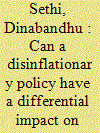

|
|
|
|
|
| Summary/Abstract |
This article examines the sectoral impact of disinflationary monetary policy by calculating the sacrifice ratios for several Organisation for Economic Co-operation and Development (OECD) and non-OECD countries. Sacrifice ratios calculated through the episode method reveal that disinflationary monetary policy has a differential impact across three sectors in both OECD and non-OECD countries. Of the three sectors, the industry and service sectors show significant output loss due to a tight monetary policy in OECD and non-OECD countries. But the agricultural sector shows a differential impact of disinflation policy: It shows a negative sacrifice ratio in OECD countries indicating that output growth is insignificantly affected by a tight monetary policy while non-OECD countries yield positive sacrifice ratios, suggesting that the output loss is significant. Further, it is observed that sacrifice ratios calculated from aggregate data are different from ratios calculated from sectoral data.
|
|
|
|
|
|
|
|
|
|
|
|
|
|
|
|
| 9 |
ID:
105071
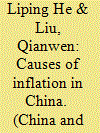

|
|
|
|
|
| Publication |
2011.
|
| Summary/Abstract |
This paper argues that the main causes of inflation in China since the early 21st century are changes in the public's inflation expectations. The conventional wisdom, the quantity theory of money, may not be adequate to capture the relationship between price changes and money supply growth, as the economic system evolves and people's income and wealth grow. An examination of China's GDP deflator and broad money supply relative to nominal GDP shows that the relationship between the two series is relatively weak. A further examination of China's monthly CPI series over the period 2001-2010 reveals that the autoregressive models are a better fit than the moving average models, which suggests that the role of CPI expectations has been significant and important. Because of the importance of inflation expectations in CPI movement, we believe the Central Bank's monetary policy that targets CPI inflation should emphasize the use of policy instruments that have direct and strong communication links with the public. Quantitative measures would have their own use, but their effectiveness would be unlikely to match that of interest rate measures, especially from a short-term perspective.
|
|
|
|
|
|
|
|
|
|
|
|
|
|
|
|
| 10 |
ID:
120626


|
|
|
|
|
| Publication |
2013.
|
| Summary/Abstract |
Using a unique monthly data set over the period 2000:1-2008:12, this paper presents empirical findings on China's central bank, the People's Bank of China, from the viewpoint of its financial strength and the cost of monetary policy instruments. The results show that PBoC is constrained by the costs of its monetary policy instruments. PBoC tend to use less costly but market-distorting instruments such as the deposit interest rate cap and reserve-ratio requirements, rather than more market-oriented but more costly instruments such as central bank note issuance. These costs remain under control today, but may rise in the future as PBoC accumulates more foreign assets. This, in turn, will jeopardize the Chinese monetary authority's capability to maintain price stability.
|
|
|
|
|
|
|
|
|
|
|
|
|
|
|
|
| 11 |
ID:
074902
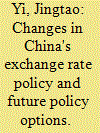

|
|
|
|
|
| Publication |
2006.
|
| Summary/Abstract |
In responding to US pressure for changes in China's exchange rate regime, Chinese Premier Wen Jiabao has repeatedly said that the reform of the RMB exchange rate was a matter of China's sovereignty and that any external pressure or politicisation of an economic matter would not be conducive to a solution of the issue.
|
|
|
|
|
|
|
|
|
|
|
|
|
|
|
|
| 12 |
ID:
101935
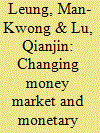

|
|
|
|
|
| Publication |
2011.
|
| Summary/Abstract |
This paper uses an institutional perspective to examine the changing monetary policy operations in China since the 1978 reform. It shows that the establishment of money markets has enabled the central bank to shift its policy approach of direct control over credits to a set of indirect monetary tools. Under the constraint of exchange rate stability and other institutional factors, the effectiveness of these indirect tools is limited. Establishing an interbank money market policy rate through SHIBOR will provide a means of signaling the cost of funds to banks and the public. Its success in China is conditional on improved corporate governance and the competitive structure of banks, increased flexibility in its exchange rate determination, and a more cost-conscious state sector.
|
|
|
|
|
|
|
|
|
|
|
|
|
|
|
|
| 13 |
ID:
078215
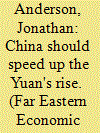

|
|
|
| 14 |
ID:
120840
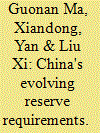

|
|
|
|
|
| Publication |
2013.
|
| Summary/Abstract |
We examine the role of reserve requirements as a cheaper substitute for the open market operations of the People's Bank of China (PBC) to sterilise foreign exchange interventions in recent years. China's reserve requirements have also been used to address a range of other policy objectives, not least macroeconomic management, financial stability and credit policy. The preference for reserve requirements reflects the size of sterilisation and the associated costs, in a quantity-oriented monetary policy framework faced with policy dilemmas. The PBC often finds it easier to make reserve requirement adjustments than interest rate decisions and enjoys greater discretion in applying this tool. The monetary effects of reserve requirements need to be explored not in isolation but in conjunction with other policy actions. Depending on the policy mix, higher reserve requirements tend to signal a tightening bias, to squeeze excess reserves of banks, to push market interest rates higher and to help widen net interest spreads, thus tightening domestic monetary conditions. Reserve requirements, however, impose an implicit tax burden on Chinese banks, albeit the latter seem to pass through a large but incomplete portion of these costs to their customers.
|
|
|
|
|
|
|
|
|
|
|
|
|
|
|
|
| 15 |
ID:
032835
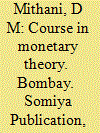

|
|
|
|
|
| Publication |
Bombay, Somiya Publication, 1970.
|
| Description |
686p.
|
|
|
|
|
|
|
|
|
|
|
|
Copies: C:1/I:0,R:0,Q:0
Circulation
| Accession# | Call# | Current Location | Status | Policy | Location |
| 004397 | 332.46/MIT 004397 | Main | On Shelf | General | |
|
|
|
|
| 16 |
ID:
049174


|
|
|
|
|
| Publication |
Washington, International Monetary Fund, 1997.
|
| Description |
v, 52p.
|
| Series |
Occasional paper; 151
|
| Standard Number |
1557756686
|
|
|
|
|
|
|
|
|
|
|
|
Copies: C:1/I:0,R:0,Q:0
Circulation
| Accession# | Call# | Current Location | Status | Policy | Location |
| 039409 | 332.4/BAL 039409 | Main | On Shelf | General | |
|
|
|
|
| 17 |
ID:
128835


|
|
|
|
|
| Publication |
2014.
|
| Summary/Abstract |
The propensity of cutting some government spending during the crisis time generates the incentive for some policy-makers and governments to modify certain expenses irrespective to output variations. The goal of this paper is to analyse the cyclical properties of defence expenditure in Spain (1978-2009) and to characterize the consequences of economic and political cycles on this public spending.
|
|
|
|
|
|
|
|
|
|
|
|
|
|
|
|
| 18 |
ID:
133268
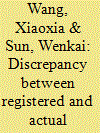

|
|
|
|
|
| Publication |
2014.
|
| Summary/Abstract |
The unemployment rate is a key indicator of labor market and economic performance. Based on a unique survey, we estimate the unemployment rate at 13.44 percent in 30 provincial capital cities in China in 2007, which is well above the officially announced registered unemployment rate. The discrepancy results from inaccuracy in the calculation of registered unemployment. The discrepancy is not stably evolving across regions or over the years, making it difficult to recover the true unemployment rate using a simple multiplier approach. We further investigate the sources of the discrepancy by examining the determinants of unemployment registration. It is evident that participation in certain public activities, which would facilitate the spread of knowledge related to job-searching and unemployment registration, encouraged unemployment registration. Social attention to government anti-unemployment programs also encouraged unemployment registration. These findings confirm the behavioral hypothesis that incomplete knowledge and limited attention can cause deviation from optimal choice. The policy implications of the findings of the study are discussed.
|
|
|
|
|
|
|
|
|
|
|
|
|
|
|
|
| 19 |
ID:
127913
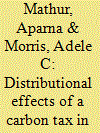

|
|
|
|
|
| Publication |
2014.
|
| Summary/Abstract |
This paper analyzes the distributional implications of an illustrative $15 carbon tax imposed in 2010 on carbon in fossil fuels. We analyze its incidence across income classes and regions, both in isolation and when combined with measures that apply the carbon tax revenue to lowering other distortionary taxes in the economy. Consistent with earlier findings, we find that a carbon tax is regressive. Using tax swap simulations, we then subtract the burden of other taxes the carbon tax revenue could displace, and compute the net effect on households under three assumptions about how capital and labor income might be distributed.
|
|
|
|
|
|
|
|
|
|
|
|
|
|
|
|
| 20 |
ID:
076909
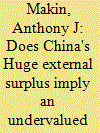

|
|
|
|
|
|
|
|